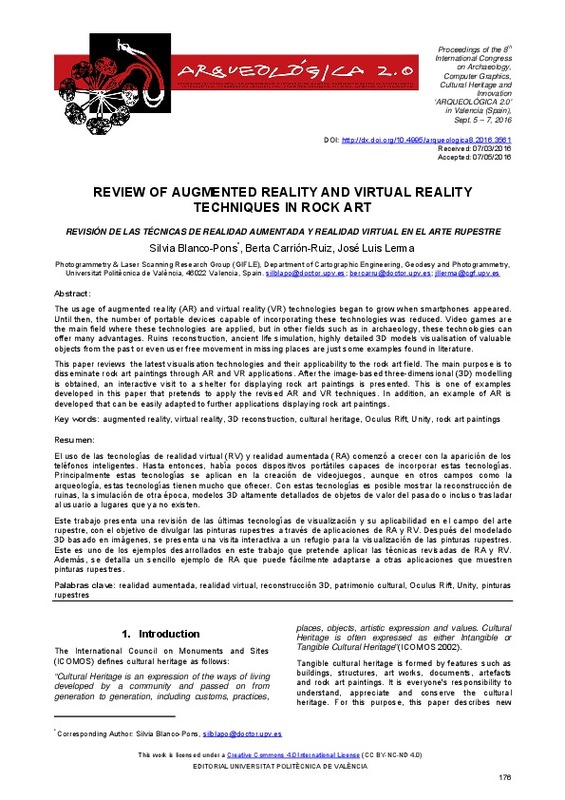JavaScript is disabled for your browser. Some features of this site may not work without it.
Buscar en RiuNet
Listar
Mi cuenta
Estadísticas
Ayuda RiuNet
Admin. UPV
REVIEW OF AUGMENTED REALITY AND VIRTUAL REALITY TECHNIQUES IN ROCK ART
Mostrar el registro sencillo del ítem
Ficheros en el ítem
| dc.contributor.author | Blanco Pons, Silvia
|
es_ES |
| dc.contributor.author | Carrión Ruiz, Berta
|
es_ES |
| dc.contributor.author | Lerma, José Luis
|
es_ES |
| dc.date.accessioned | 2018-02-05T07:44:30Z | |
| dc.date.available | 2018-02-05T07:44:30Z | |
| dc.date.issued | 2016-10-27 | |
| dc.identifier.isbn | 9788490484555 | |
| dc.identifier.uri | http://hdl.handle.net/10251/96444 | |
| dc.description.abstract | [EN] The usage of augmented reality (AR) and virtual reality (VR) technologies began to grow when smartphones appeared. Until then, the number of portable devices capable of incorporating these technologies was reduced. Video games are the main field where these technologies are applied, but in other fields such as in archaeology, these technologies can offer many advantages. Ruins reconstruction, ancient life simulation, highly detailed 3D models visualisation of valuable objects from the past or even user free movement in missing places are just some examples found in literature. This paper reviews the latest visualisation technologies and their applicability to the rock art field. The main purpose is to disseminate rock art paintings through AR and VR applications. After the image-based three-dimensional (3D) modelling is obtained, an interactive visit to a shelter for displaying rock art paintings is presented. This is one of examples developed in this paper that pretends to apply the revised AR and VR techniques. In addition, an example of AR is developed that can be easily adapted to further applications displaying rock art paintings. | es_ES |
| dc.description.abstract | [ES] El uso de las tecnologías de realidad virtual (RV) y realidad aumentada (RA) comenzó a crecer con la aparición de los teléfonos inteligentes. Hasta entonces, había pocos dispositivos portátiles capaces de incorporar estas tecnologías. Principalmente estas tecnologías se aplican en la creación de videojuegos, aunque en otros campos como la arqueología, estas tecnologías tienen mucho que ofrecer. Con estas tecnologías es posible mostrar la reconstrucción de ruinas, la simulación de otra época, modelos 3D altamente detallados de objetos de valor del pasado o incluso trasladar al usuario a lugares que ya no existen. Este trabajo presenta una revisión de las últimas tecnologías de visualización y su aplicabilidad en el campo del arte rupestre, con el objetivo de divulgar las pinturas rupestres a través de aplicaciones de RA y RV. Después del modelado 3D basado en imágenes, se presenta una visita interactiva a un refugio para la visualización de las pinturas rupestres. Este es uno de los ejemplos desarrollados en este trabajo que pretende aplicar las técnicas revisadas de RA y RV. Además, se detalla un sencillo ejemplo de RA que puede fácilmente adaptarse a otras aplicaciones que muestren pinturas rupestres. | es_ES |
| dc.format.extent | 8 | es_ES |
| dc.language | Inglés | es_ES |
| dc.publisher | Editorial Universitat Politècnica de València | es_ES |
| dc.relation.ispartof | 8th International congress on archaeology, computer graphics, cultural heritage and innovation | es_ES |
| dc.rights | Reconocimiento - No comercial - Sin obra derivada (by-nc-nd) | es_ES |
| dc.subject | Augmented reality | es_ES |
| dc.subject | Virtual reality | es_ES |
| dc.subject | 3D reconstruction | es_ES |
| dc.subject | Cultural heritage | es_ES |
| dc.subject | Oculus Rift | es_ES |
| dc.subject | Unity | es_ES |
| dc.subject | Rock art paintings | es_ES |
| dc.title | REVIEW OF AUGMENTED REALITY AND VIRTUAL REALITY TECHNIQUES IN ROCK ART | es_ES |
| dc.title.alternative | REVISIÓN DE LAS TÉCNICAS DE REALIDAD AUMENTADA Y REALIDAD VIRTUAL EN EL ARTE RUPESTRE | es_ES |
| dc.type | Capítulo de libro | es_ES |
| dc.type | Comunicación en congreso | es_ES |
| dc.identifier.doi | 10.4995/arqueologica8.2016.3561 | |
| dc.rights.accessRights | Abierto | es_ES |
| dc.contributor.affiliation | Universitat Politècnica de València. Departamento de Ingeniería Cartográfica Geodesia y Fotogrametría - Departament d'Enginyeria Cartogràfica, Geodèsia i Fotogrametria | es_ES |
| dc.contributor.affiliation | Universitat Politècnica de València. Escuela Técnica Superior de Ingeniería Geodésica, Cartográfica y Topográfica - Escola Tècnica Superior d'Enginyeria Geodèsica, Cartogràfica i Topogràfica | es_ES |
| dc.description.bibliographicCitation | Blanco Pons, S.; Carrión Ruiz, B.; Lerma, JL. (2016). REVIEW OF AUGMENTED REALITY AND VIRTUAL REALITY TECHNIQUES IN ROCK ART. En 8th International congress on archaeology, computer graphics, cultural heritage and innovation. Editorial Universitat Politècnica de València. 176-183. https://doi.org/10.4995/arqueologica8.2016.3561 | es_ES |
| dc.description.accrualMethod | OCS | es_ES |
| dc.relation.conferencename | ARQUEOLÓGICA 2.0 - 8th International Congress on Archaeology, Computer Graphics, Cultural Heritage and Innovation | es_ES |
| dc.relation.conferencedate | September 05-07,2016 | es_ES |
| dc.relation.conferenceplace | Valencia, Spain | es_ES |
| dc.relation.publisherversion | http://ocs.editorial.upv.es/index.php/arqueologica20/arqueologica8/paper/view/3561 | es_ES |
| dc.description.upvformatpinicio | 176 | es_ES |
| dc.description.upvformatpfin | 183 | es_ES |
| dc.type.version | info:eu-repo/semantics/publishedVersion | es_ES |
| dc.relation.pasarela | OCS\3561 | es_ES |








